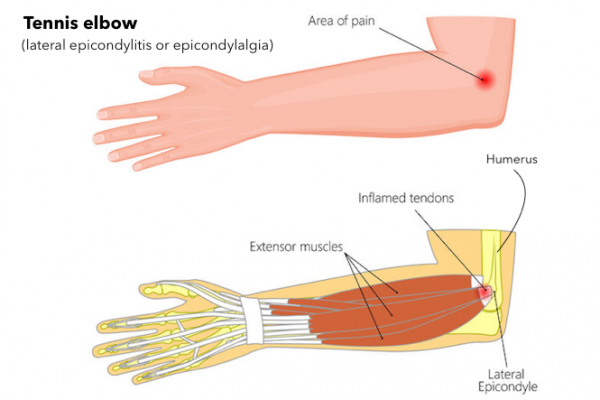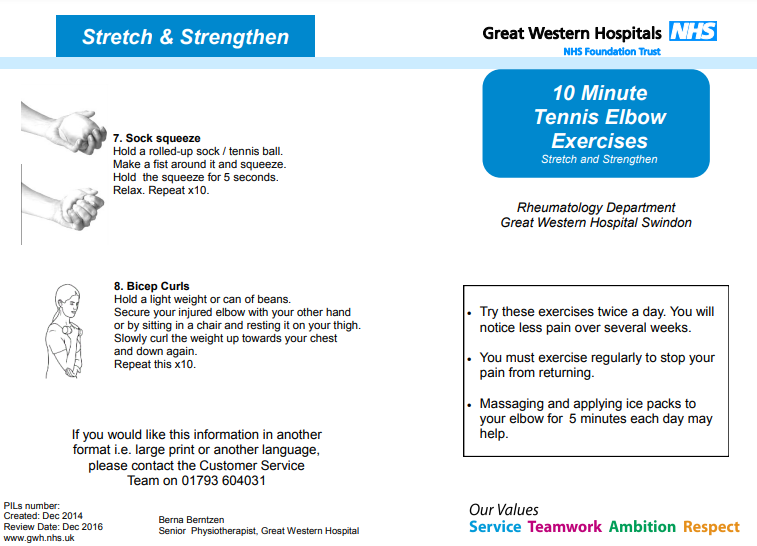Tennis elbow
Also known as lateral epicondylitis or epicondylalgia
Key points about tennis elbow
- Tennis elbow is a condition that causes pain around the outside of the elbow.
- Tennis elbow is commonly triggered by overuse of the muscles and tendons of the forearm, near the elbow joint.
- The pain is thought to be caused by swelling or small micro-tears in the tendons.
- Pain from tennis elbow can last for 6 to 12 weeks but varies.
- Treatment focuses on rest, pain relief and progressive strengthening exercises for the forearm, elbow and shoulder.
- Preventing tennis elbow recurring may involve avoiding doing the activity that is causing pain or finding a way of doing it that does not increase the pain.

The medical name for tennis elbow is lateral epicondylitis or epicondylalgia because the pain is felt around the part of the humerus bone called the lateral epicondyle. In most cases, it is not possible (nor necessary) to specify exactly where the pain comes from.

Image credit: 123rf
Many people who get tennis elbow work in a way or play sport that involves moving their arm in a repetitive way. Examples include activities that involve:
- Fine, repetitive hand and wrist movements, such as using scissors or typing.
- Repeatedly bending the elbow, such as playing the violin, cutting with a knife or using a paintbrush.
- Twisting movements such as wringing clothes or using a screwdriver.
- Playing racquet sports, such as tennis, badminton or squash (despite being called tennis elbow, racquet sports like tennis are only thought to be the cause in about 5 in 100 cases).
- Throwing sports, such as the javelin or discus.
Tennis elbow can also occur:
- After a knock or a bang to the elbow.
- If you suddenly do a lot of something you’re not used to, for example, lots of gardening or playing tennis while on holiday.
The main symptom of tennis elbow is pain on the outside of the upper forearm just below the bend of your elbow. You may also:
- feel pain travelling from the outside of the elbow towards the wrist when twisting your forearm, for example when opening a jar
- have pain when lifting, bending or extending your arm
- find it difficult to grip items like pens
- notice stiffness in the affected arm.
Given rest and time, tennis elbow can get better on its own. A full recovery is made in most cases within a year.
Visit your healthcare provider or physiotherapist if the pain continues after you have rested the elbow for one to two weeks, if there is throbbing pain that keeps you awake at night or if you notice wasting of your forearm muscles.
To diagnose tennis elbow, your healthcare provider will examine you for:
- pain or tenderness when they feel the tendons and muscles at the upper arm bone, over the outside of the elbow
- pain near the elbow when the wrist is bent backwards or when you grip a hand (as in a handshake).
Further tests, such as ultrasound or MRIs (magnetic resonance imaging) are usually not needed to diagnose tennis elbow.
Treatment for tennis elbow aims to reduce elbow pain and restore normal movement and function. Self-care measures and long term strengthening are key to the treatment of tennis elbow. Treatment may include physiotherapy and medication. Surgery is only an option in the rare case when pain does not subside with continued self-care, strengthening exercises, physiotherapy and medication.
Self-care
Tennis elbow takes time to heal. You may be able to help ease pain by:
- Avoiding the activity that causes the symptoms for at least 2 weeks.
- Applying an ice pack, like a packet of frozen peas wrapped in a towel, to the sore area of your elbow for 10 minutes, 2 to 3 times a day.
- Using a special brace that wraps around the upper part of your forearm. Alternatively, wearing a wrist splint may ease pain by helping to rest the muscles that pull on your elbow. Such splints or brace can often be bought over the counter from a pharmacy.
Physiotherapy
Strengthening the wrist and shoulder muscles is extremely important for the long term care of tennis elbow. A physiotherapist can show you progressive exercises to strengthen the muscles of your forearm and the shoulder. The physiotherapist will explore how the pain influences your life and devise an individual plan with you. They will help you to work out how to move and complete your required activities in different ways, should the pain persist.
Medication
Anti-inflammatory medications, such as ibuprofen may be helpful for a few days. Some anti-inflammatories are available as a cream or gel that can be rubbed directly over the painful area. If you cannot take anti-inflammatory pain medication, other pain medication such as paracetamol may be helpful.
Corticosteroids may be injected around the area where the tendon attaches to the bone to help decrease the swelling and pain. Steroid injections may help ease pain in the short term but pain tends to come back in many people. You would need to rest the arm for a few days after such injection, and slowly return to the progressive strengthening exercise and usual activity.
Treatment for severe symptoms
Surgery is only considered in very rare cases when severe pain continues after 6 to 12 months of rest and treatment. Your GP can give you more information about this option.
Apps reviewed by Healthify
You may find it useful to look at some Physiotherapy and exercise apps, Pain management apps, and Joint and bone health apps.
It can be difficult to avoid getting tennis elbow and many people find it hard to stop doing the activities that cause it and rest. The measures below may help you prevent tennis elbow developing or recurring.
In general
- Avoid doing the activity that is causing pain or find a way of doing it that does not increase the pain.
- Strengthen your shoulder muscles and forearm muscles to spread the load to the larger muscles.
- Slowly increase your forearm strength and ease your way gently back into twisting activities to return to your usual activities as soon as possible.
If your tennis elbow is due to a repetitive sports activity
- Consider getting some coaching advice to help improve or modify your technique.
- Warm up properly and gently stretch your arm muscles to help avoid injury before playing.
- Use lightweight equipment and enlarge their grip size to decrease the strain on your tendons.
If your symptoms are work-related
- Discuss your options with your employer.
- Seek help from an occupational physiotherapist or other health care provider. They will work with you to find strategies or solutions that allow you to continue with your responsibilities at work without making the pain worse.
- There may be other tasks you could do while your elbow is resting or there may be changes that could be made to the way you work that could reduce the risk of it reoccurring.
- Alternate tasks with different demands on the wrist and forearm, if possible, and take regular breaks when you are working.
The following links have more information about tennis elbow. Be aware that websites from other countries may have information that differs from New Zealand recommendations.
Tennis elbow – condition leaflet(external link) Patient Info, UK 2017
Repetitive stress injuries(external link) TeensHealth from The Nemours Foundation, 2019
Decision aid for tennis elbow(external link) Patient Info, UK, 2018
Apps
Physiotherapy and exercise apps
Pain management apps
Joint and bone health apps
Resources
10 minutes tennis elbow exercises(external link) Great Western Hospitals NHS, UK, 2016
Tennis elbow or lateral epicondylitis(external link) Nuffield Orthopaedic Centre, NHS Trust, 2023
Tennis elbow leaflet [PDF, 900 KB] Arthritis Research UK
Brochures

Great Western Hospitals NHS, UK, 2016
![]()
Nuffield Orthopaedic Centre, NHS Trust, 2023

Arthritis Research UK
Credits: Healthify editorial team. Healthify is brought to you by Health Navigator Charitable Trust.
Reviewed by: Associate Professor Gisela Sole, School of Physiotherapy, University of Otago
Last reviewed:
Page last updated:





